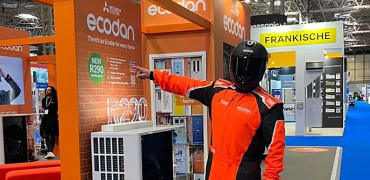Tackling the climate crisis means we must achieve the UK’s legally binding target of net zero by 2050, but this is simply not possible if we continue to use gas heating for the nation’s homes.
Yet more than 8 out of 10 houses still rely on gas and the uptake of renewable heating systems such as heat pumps continues to lag ambition, with only around a tenth of the 600,000 a year target fitted in 2023.
Part of this is misinformation about heat pump technology, put out by those with a vested interest in keeping the status quo. However, another part is the higher costs of installation, although the Government’s Boiler Upgrade Scheme of a £7,500 contribution is making a difference.
A large part of that cost though comes in a retrofit situation, where the homeowner may have to replace radiators and pipework within the home. More than 80% of the houses that we will occupy in 2050 are already built, so the retrofit challenge is something that we will have to address.
And this is where a white paper on heat pumps and microbore piping is highlighting how heat pumps can be more readily switched with a gas boiler to keep disruption to a minimum.
Research shows that modern heat pumps can work effectively with microbore pipework
5 millions homes affected
In 2022, the UK’s Climate Change Committee noted: “We cannot reach net zero if we continue to use gas for heat. Changing how we heat our homes and buildings is essential.”
It’s therefore vital that we tackle the retrofit challenge to make the transition to low-carbon heating yet one of the hurdles to making this change is microbore pipework.
Characterised by pipes with a diameter of less than 15mm, microbore pipework gained popularity in the 1970s due to its affordability, flexibility, and ease of installation. It is used in most houses built in the 70s and 80s, meaning it is already present in up to 5 million UK homes – and it is still used today, even in new builds.
There has been a long-standing belief in the residential heating sector that microbore systems are incompatible with heat pumps, requiring costly and disruptive replacements.
However, our recent research for this white paper shows that modern heat pumps can work effectively with microbore pipework with the correct installation approach. This means that the pipes and radiators can be kept in many cases, making the transition smoother and less costly for homeowners.
The difference in Delta T
Traditional gas boilers operate at higher flow temperatures and ΔT (Delta T), which is the difference between the temperatures of the water flowing from the boiler and that coming back in return.
Air source heat pumps typically operate at lower temperatures and smaller ΔT, which can have an impact on the effectiveness of microbore piping systems.
Correct pipe sizing is an important factor for successful heat pump installations as this can affect heat transfer efficiency, meaning the system uses more energy than it should. Oversized pipes increase installation costs, while undersized pipes, particularly in microbore systems, can restrict water flow and lead to higher pressure drops.
With this in mind, we conducted research into microbore pipework and the performance of an Ecodan air source heat pump, with the aim of discovering if the two systems can be compatible.
What a result
The white paper is a result of this research, and the key conclusion is that the latest heat pumps such as the Ecodan units can be integrated with existing microbore systems, as long as the installer has used the correct design and calculations.
The key is to match the operating conditions of the heat pump with those of the existing boiler system, particularly in terms of flow temperature and ΔT.
The white paper lists a set of recommendations for installers working with microbore systems in air source heat pump retrofits, including how to match existing heating system operating conditions, and the suitability of existing heat emitters.
The white paper also includes a case study from an installer using a heat pump with a microbore system, with a strong emphasis on the importance of proper design and calculations. Getting it right can lead to considerable cost savings both in terms of new pipes and radiators as well as minimised disruption and labour.
Joanna Crown is Residential Product Marketing Manager




